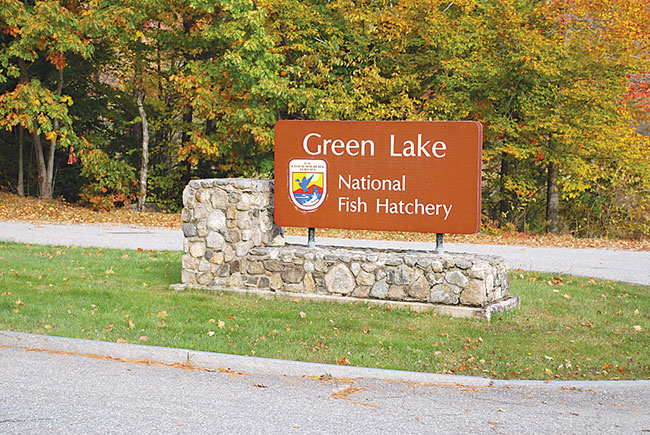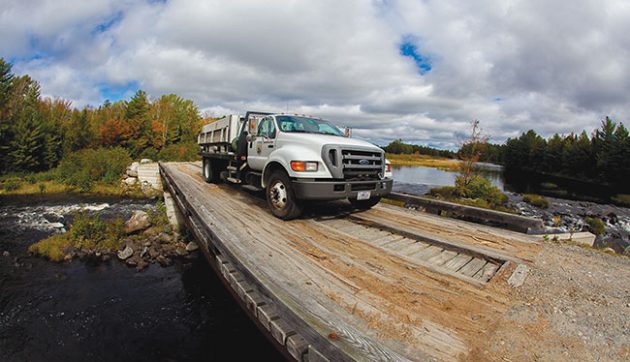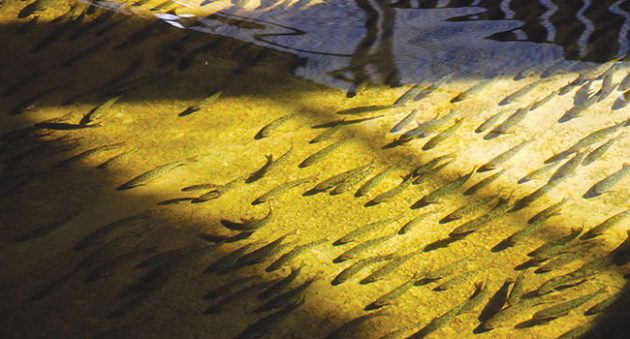
Features
Restoring the “King of Fish” at Green Lake NFH
December 8, 2022 By Julia Hollister
 Maine is the last state in the U.S. that still has wild sea-run Atlantic salmon and they need all the help they can get. (Photo: Green Lake NFH)
Maine is the last state in the U.S. that still has wild sea-run Atlantic salmon and they need all the help they can get. (Photo: Green Lake NFH) In the Atlantic Ocean, the Atlantic salmon is known as the “King of Fish.” Unfortunately, overfishing and dams once blocked their ability to reach their preferred spawning grounds.
Today, Green Lake National Fish Hatchery is working to ensure these fish continue to thrive and retain the regal title.
“Green Lake National Fish Hatchery (NFH) was authorized by Congress in 1967 for the purpose of rearing Atlantic salmon for restoration and management of the fishery in Maine and other waters in New England,” said hatchery manager, Oliver Cox. “At Green Lake NFH, we predominantly work with the Penobscot River strain of Atlantic salmon.”
Atlantic salmon is the only species cultivated at the hatchery. It was constructed in 1973 and the first fish distributions began in 1978.
Green Lake NFH is working to conserve and restore Atlantic salmon to Maine. All of the Atlantic salmon reared have been listed as an endangered species under the Endangered Species Act and are part of the Gulf of Maine Distinct Population Segment. The restoration program maintains seven river specific lines of Atlantic salmon.
The hatchery is situated on the outlet of Green Lake and is built at a lower elevation than the lake and the flow of water to the hatchery maintained by gravity The lake is about 3,000 acres and has a maximum depth of 170 feet. So, it is a good source of cold-water for growing salmonids.
Green Lake NFH utilizes an accelerated growth regime to produce about 200,000 Atlantic salmon parr and 650,000 smolts annually.
It also maintains a domestic brood line of Penobscot origin Atlantic salmon to produce about 1.3 million eyed-eggs annually. Life stages of Atlantic salmon are egg, eye eggs, fry, parr, smolt and adult.
Cox said the hatching process is lengthy.

(Photo: Green Lake NFH)
The primary production cycle for Green Lake NFH relies on receiving Atlantic salmon eyed-egg from Craig Brook National Fish Hatchery in East Orland. Adult salmon are collected from a fish lift and trapping facility at the Milford Dam on the Penobscot River, Milford, Maine.
Adults are held at Craig Brook NFH from May to December and spawned in November. Eyed-eggs are then transferred to Green Lake NFH in January and February and placed in incubation trays. Alternatively, biologists can use eggs from our domestic line.
“Our fry start hatching in late February with most hatching in March,” he said. “Fry are transferred to small circular tanks for initial feeding and rearing in April. In June, they are transferred to our outside rearing pools.”
Green Lake Hatchery has 102 circular pools where salmon continue to grow until they are released or transferred as parr in the fall, or they are held overwinter and released as a one-year-old smolts in April.
The hatchery crew tries to release the smolts to coincide with the wild smolt migration window. Following the release of smolts into freshwater, they begin their migration to the ocean. Most of the Atlantic salmon migrating from Maine rivers spend two years in the ocean.
While at sea, they migrate to the North Atlantic Ocean off West Greenland and then return as mature adults to their river of origin. The adult Atlantic salmon that return to the Penobscot River complete the hatchery cycle when they are collected and spawned at Craig Brook NFH.
“Our domestic brood line is maintained by keeping about a 1,000 of our 0+ parr each year and rearing them to maturity,” Cox said. “We spawn these fish at age 3 and 4 and then release them. Typically, the eggs from this source are transferred to the State of Maine for stocking but on occasion we will incorporate them into our production.”

(Photo: Green Lake NFH)
Green Lake Hatchery supplies most of the Atlantic salmon returning to waters.
On the Penobscot River, where most of the smolts are stocked, 88 per cent of the adult returns are the result Green Lake NFH’s smolt stocking efforts. Overall, about 76 per cent of all Atlantic salmon returns to Maine are of known hatchery origin; however, the number of hatchery origin adult returns is higher because biologists are not able to assess the origin of all adults return. Adults return from the smolt stocking can be identified by looking at the growth pattern of a fish scale or through genetic analysis.
Both require biological staff to capture and handle the adult salmon to collect scales and or tissue samples. Cox said he can identify the smolts raised at Green Lake NFH because the accelerated growth regime results in a different scale pattern than a fish raised in a natural freshwater environment. In addition, they are not able to distinguish the origin of fish that are the result of stocking eggs, fry and even some parr based on scale analysis.
“We release several life stages of Atlantic salmon,” he said. “Our one-year-old smolts are about eight inches long and weight about 2.5 ounces each. They are release in April, a little over one year after hatching. We produce over 100,000 pounds of smolts each year. Our 0+ parr are typically 4 to 5 inches long and weight 0.6 ounces each. They are released on in September and October about six months after they hatched. We release our retired brood stock. Those fish are about 20 inches long and weigh about three pounds. We also release fry and eggs.”
Other tidbits of information:
- The Atlantic salmon restoration program involves many partners including the National Marine Fisheries Service, Maine Department of Marine Resources, the Penobscot Nation, and a few non-governmental organizations.
- Maine is the last state in the U.S. that still has wild sea-run Atlantic salmon and they need all the help they can get.
- Our accelerated growth program that produces a one-year-old smolt is achieved by increasing the water temperature to advance egg and fry development. A typical wild Atlantic salmon will spend two or maybe even three years in freshwater before migrating to the ocean. It is this difference in the freshwater growth that allows us to distinguish hatchery adults form smolt stocking from other origins based on the pattern of annuli and circuli of a fish scale.
Print this page
Advertisement
- Pordenone Fiere to host AquaFarm 2023
- Hatchery stocking of black tiger shrimp to help revive Philippine industry





